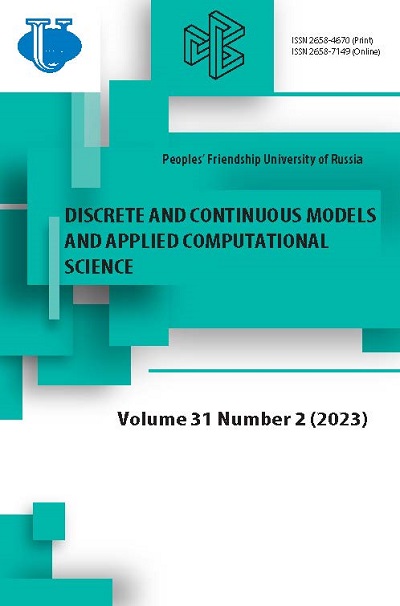Quadratures with super power convergence
- Authors: Belov A.A.1,2, Tintul M.A.1, Khokhlachev V.S.1
-
Affiliations:
- M. V. Lomonosov Moscow State University
- RUDN University
- Issue: Vol 31, No 2 (2023)
- Pages: 128-138
- Section: Articles
- URL: https://journals.rudn.ru/miph/article/view/35109
- DOI: https://doi.org/10.22363/2658-4670-2023-31-2-128-138
- EDN: https://elibrary.ru/XAUSJA
Cite item
Full Text
Abstract
The calculation of quadratures arises in many physical and technical applications. The replacement of integration variables is proposed, which dramatically increases the accuracy of the formula of averages. For infinitely smooth integrand functions, the convergence law becomes super power. It is significantly faster than the power law and is close to exponential one. For integrals with bounded smoothness, power convergence is realized with the maximum achievable order of accuracy.
Full Text
1. Introduction Applied tasks. In many physical problems, it is required to approximate integrals that are not taken in elementary functions. Here are some examples: 2. Calculation of special functions of mathematical physics: Fermi-Dirac functions equal to the moments of the Fermi distribution, gamma function, cylindrical functions and a number of others. 3. Calculation of Fourier coefficients of a given function, Fourier and Laplace transforms. 4. Numerical solution of integral equations, both correctly posed and incorrect. 5. Solving boundary value problems for partial differential equations (including eigenvalue problems) written in integral form, etc. Such integrals must be calculated with high accuracy up to computer round-off errors. Calculation of quadratures. Commonly, trapezoid, mean and Simpson methods on a uniform grid are used for grid calculation of quadratures. The majorant error estimation is well known for these methods. For trapezoid and mean formulas it isAbout the authors
Aleksandr A. Belov
M. V. Lomonosov Moscow State University; RUDN University
Author for correspondence.
Email: aa.belov@physics.msu.ru
ORCID iD: 0000-0002-0918-9263
Scopus Author ID: 57191950560
ResearcherId: Q-5064-2016
Candidate of Physical and Mathematical Sciences, Researcher of Faculty of Physics, M. V. Lomonosov Moscow State University; Assistant Professor of Department of Applied Probability and Informatics of Peoples’ Friendship University of Russia
1, bld. 2, Leninskie Gory, Moscow, 119991, Russian Federation; 6, Miklukho-Maklaya St., Moscow, 117198, Russian FederationMaxim A. Tintul
M. V. Lomonosov Moscow State University
Email: maksim.tintul@mail.ru
ORCID iD: 0000-0002-5466-1221
Master’s Degree Student of Faculty of Physics
1, bld. 2, Leninskie Gory, Moscow, 119991, Russian FederationValentin S. Khokhlachev
M. V. Lomonosov Moscow State University
Email: valentin.mycroft@yandex.ru
ORCID iD: 0000-0002-6590-5914
Master’s Degree Student of Faculty of Physics
1, bld. 2, Leninskie Gory, Moscow, 119991, Russian FederationReferences
- N. N. Kalitkin and E. A. Alshina, Numerical Methods. Vol. 1: Numerical Analysis [Chislennye Metody. T. 1: Chislennyi analiz]. Moscow: Akademiya, 2013, in Russian.
- N. N. Kalitkin, A. B. Alshin, E. A. Alshina, and V. B. Rogov, Computations with Quasi-Uniform Grids [Vychisleniya na kvaziravnomernykh setkakh]. Moscow: Fizmatlit, 2005, in Russian.
- L. N. Trefethen and J. A. C. Weideman, “The exponentially convergent trapezoidal rule,” SIAM Review, vol. 56, no. 3, pp. 385-458, 2014. doi: 10.1137/130932132.
- N. N. Kalitkin and S. A. Kolganov, “Quadrature formulas with exponential convergence and calculation of the Fermi-Dirac integrals,” Doklady Mathematics, vol. 95, no. 2, pp. 157-160, 2017. doi: 10.1134/S1064562417020156.
- N. N. Kalitkin and S. A. Kolganov, “Computing the Fermi-Dirac functions by exponentially convergent quadratures,” Mathematical Models and Computer Simulations, vol. 10, no. 4, pp. 472-482, 2018. doi: 10.1134/S2070048218040063.
- T. Sag and G. Szekeres, “Numerical evaluation of high-dimensional integrals,” Math. Comp., vol. 18, pp. 245-253, 1964. doi: 10.1090/S0025-5718-1964-0165689-X.
- A. Sidi, “Numerical evaluation of high-dimensional integrals,” International Series Numer. Math., vol. 112, pp. 359-373, 1993. doi: 10.1007/978-3-0348-6338-4_27.
- M. Iri, S. Moriguti, and Y. Takasawa, “On a certain quadrature formula,” International Series Numer. Math., vol. 17, pp. 3-20, 1987. doi: 10.1016/0377-0427(87)90034-3.
- M. Mori, “An IMT-Type Double Exponential Formula for Numerical Integration,” Publ. Res. Inst. Math. Sci. Kyoto Univ., vol. 14, no. 3, pp. 713-729, 1978. doi: 10.2977/prims/1195188835.
- A. A. Belov, N. N. Kalitkin, and V. S. Khokhlachev, “Improved error estimates for an exponentially convergent quadratures [Uluchshennyye otsenki pogreshnosti dlya eksponentsial’no skhodyashchikhsya kvadratur],” Preprints of IPM im. M. V. Keldysh, no. 75, 2020, in Russian. doi: 10.20948/prepr-2020-75.
- V. S. Khokhlachev, A. A. Belov, and N. N. Kalitkin, “Improvement of error estimates for exponentially convergent quadratures [Uluchsheniye otsenok pogreshnosti dlya eksponentsial’no skhodyashchikhsya kvadratur],” Izv. RAN. Ser. fiz., vol. 85, no. 2, pp. 282-288, 2021, in Russian. doi: 10.31857/S0367676521010166.
















